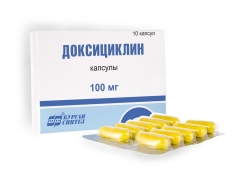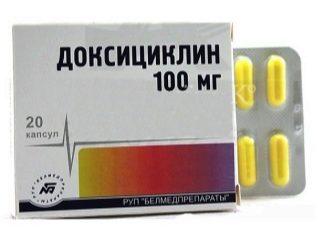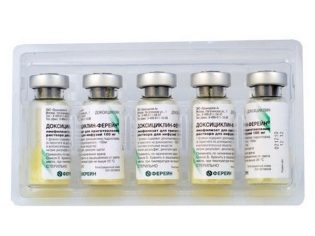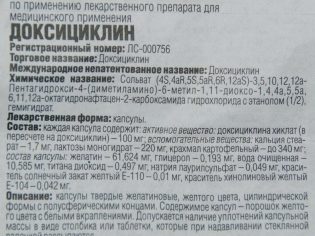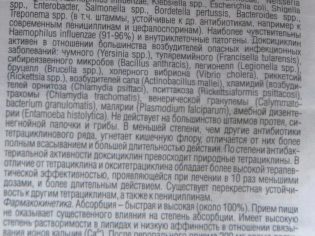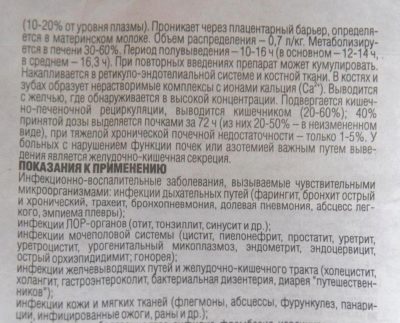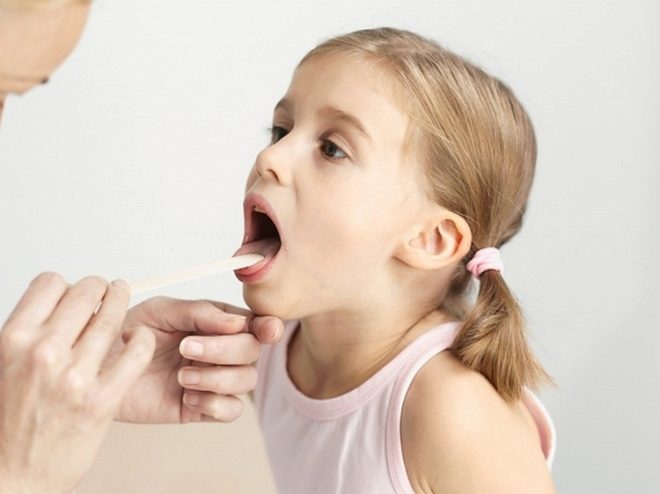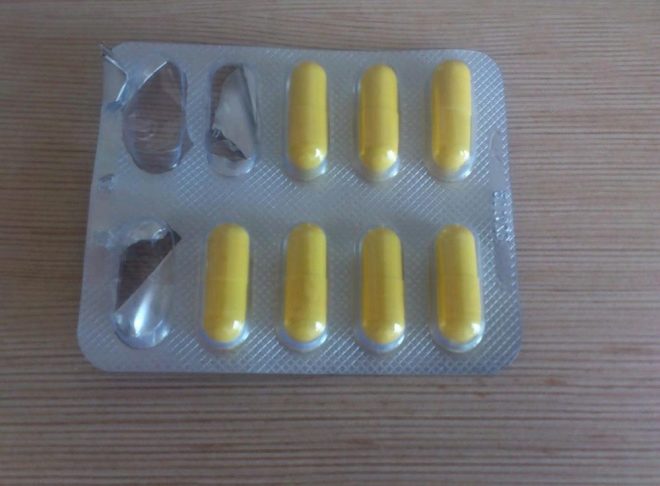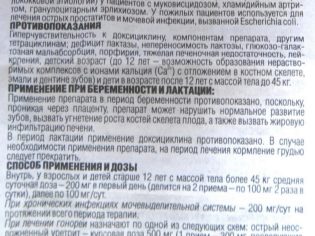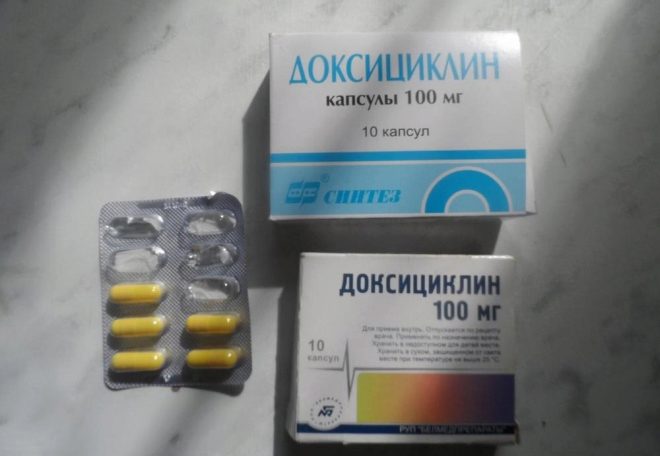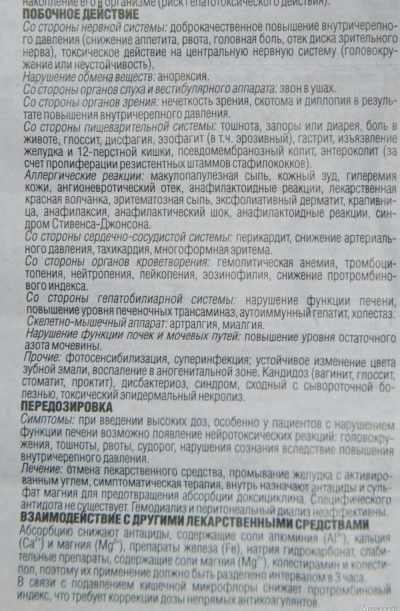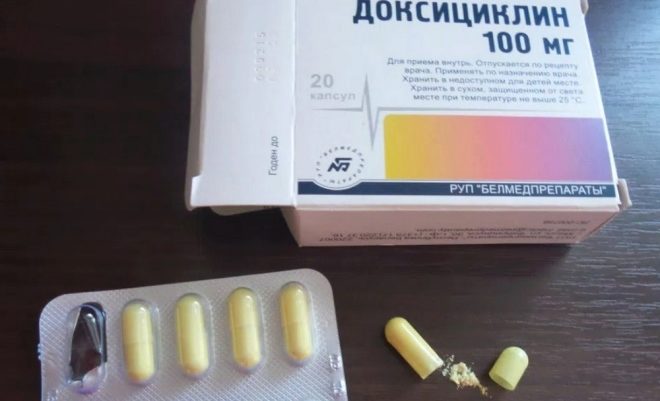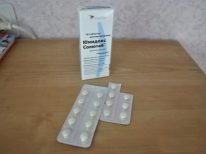Doxycycline for children
Doxycycline has been shown to be effective in many infections, so it is often prescribed for adults. But is it possible to give it to children, how does the children's organism react to this antibiotic and according to what scheme is it taken?
Release form
Doxycycline is available in 2 types:
- Capsules They have a cylindrical shape, yellow color and contents in the form of a yellow-white powder. One pack contains 10 or 20 capsules.
- Ampoules or vials of lyophilized powder. They are packed in a carton of 5. 10 or 50 pieces.
Composition
The main component of the drug is doxycycline hydrochloride. This compound in 1 capsule is 100 mg, and in one vial for injection can be both 100 and 200 mg.
Additional substances in the capsules are lactose, calcium stearate, starch, glycerol, gelatin and other compounds. In the injectable form, in addition to the active ingredient, edetate disodium and sodium disulfite are present.
Operating principle
The drug has a bacteriostatic effect on such microorganisms:
- Clostridia;
- Gonococci;
- Hemophilic sticks;
- Staphylococcus;
- Actinomycetes;
- Salmonella;
- Enterobacteria;
- Streptococci;
- Listeria;
- Rickettsia;
- Intestinal sticks;
- Treponema;
- Brucella;
- Cholera vibrios;
- Mycoplasma;
- Shigella;
- Klebsiella;
- Whooping cough sticks;
- Legionella;
- Chlamydia;
- Pathogens of plague, malaria, anthrax and tularemia.
Doxycycline intake inhibits protein synthesis in microbial cells. Resistance to this antibiotic is noted in Proteus, bacteroids, pyocyanic sticks and serratia. This drug is inactive against fungi and viruses.
Indications
Doxycycline use is justified for infections that cause pathogens that are sensitive to such an antibacterial agent.
The drug is prescribed for:
- Otitis, sinusitis and other lesions of the upper respiratory tract;
- Lung abscess, bronchopneumonia, tracheitis, pharyngitis and other infections of the respiratory system;
- Urethritis, cystitis and other infections affecting the urogenital organs;
- Cholangitis, enterocolitis, cholecystitis and other gastrointestinal pathologies of infectious nature;
- Boils, infected wounds, felons, phlegmon and other infectious lesions of soft tissue or skin;
- Eye infections;
- Chlamydia;
- Syphilis;
- Tief;
- Lyme disease;
- Dysentery;
- Cholera;
- Tularemia;
- Legionellosis;
- Rickettsiosis;
- Gonorrhea;
- Malaria and many other infections.
When it is necessary to take antibiotics, you will learn from the following video.
At what age can you give children?
Doxycycline is contraindicated in children under 8 years old, since such a medicine has the ability to bind with calcium, as a result, insoluble complexes form in the bones and teeth of a child, disrupting their development. For this reason, at the age of 6 years or younger, the medication is used extremely rarely (for health reasons). The annotation to the capsules also noted that when the child weighs less than 45 kg, the drug should not be given to children under 12 years of age.
Contraindications
The drug is not used:
- If you are allergic to tetracycline antibiotics and other components of the drug;
- With severe liver failure;
- Porphyria;
- When leukopenia.
Capsules are also not used for glucose-galactose malabsorption and lack of lactase.
Side effects
- The digestive system of a child may react to doxycycline with nausea, loss of appetite, constipation, problems with swallowing, vomiting, loose stools and other negative symptoms.
- Taking the medication may provoke allergies, such as itching or angioedema.
- Doxycycline often has a negative effect on blood formation; therefore, in the blood test some children will experience a decrease in platelets and neutrophils, and sometimes signs of hemolytic anemia are found.
- During treatment, a temporary increase in the level of bilirubin and liver enzymes is also possible.
- Doxycycline can cause intestinal dysbiosis or candidiasis.
- Often, the child after the use of such drugs changes the color of the teeth.
Instructions for use
Doxycycline capsules should be taken during the day, drinking plenty of water or during a meal.
Most often, Doxycycline capsules are prescribed for children weighing more than 45 kg according to this scheme:
- On the first day, the dosage of the drug will be 200 mg of doxycycline, so the child is given 1 capsule twice a day.
- From the second day, the medication is taken in 1 capsule per day, that is, the daily dose is 100 mg of the active compound.
For urethritis, syphilis, chlamydia, acne and some other infections, other treatment regimens are used, which the doctor prescribes individually for each patient.
Doxycycline is prescribed intravenously for severe infections, when the patient's condition is severely deteriorated. As soon as it improves, immediately go to the reception inside. The dosage of injections for the child is calculated on the basis of its mass. On the first day of treatment, the weight of the small patient in kilograms is multiplied by 4 and the resulting amount of mg of doxycycline is administered once or divided into two infusions. Further daily dosage is 2-4 mg / kg.
For injection, the powder from the ampoule or vial is diluted with saline or sterile water in a volume of 10 ml. The resulting solution is injected in 250-500 ml of saline or glucose solution, after which the drug is administered drip for 1-4 hours.
In the following short video, Dr. Komarovsky clarifies how to take antibiotics correctly.
Overdose
Too high a dose of Doxycycline can have a neurotoxic effect, which will manifest itself as nausea, cramps, dizziness, impaired consciousness and other symptoms. For treatment, the drug should be removed, the stomach should be flushed, antacids and other symptomatic agents should be given to the patient.
Interaction with other drugs
- Doxycycline is incompatible with calcium, magnesium, and iron preparations, as well as antacids, since it forms inactive chelate complexes with them. For this reason, there should be about 3 hours between taking an antibiotic and eating calcium-rich foods (dairy products).
- The effect of the drug is reduced if barbiturates, phenytoin or carbamazepine are prescribed at the same time.
- Doxycycline and other antibiotics should not be given at the same time if they have a bactericidal effect (for example, cephalosporins).
- Since the drug inhibits the intestinal microflora, this may affect the dosage of indirect anticoagulants.
- If the drug is administered along with retinol, this may increase intracranial pressure.
Terms of sale and storage
To purchase the drug in a pharmacy requires a prescription from a doctor. The average price of 10 capsules is 20 rubles. Doxycycline storage is recommended in a dry place at temperatures below 25 degrees Celsius. Such a place must be inaccessible to children and hidden from sunlight. Shelf life of capsules - 4 years, injectable form - 2 years.
Reviews
There are many positive reviews about the treatment of the child with doxycycline, in which mothers mention the effectiveness of this antibiotic for various infections. Also to the advantages of the drug include its low cost.As for the deficiencies of the medication, most often complain about the side effects of the digestive tract.
Analogs
The most popular analogue of doxycycline is Unidox Solutab. The main advantage of this medicine is its form. It is a pill that can be swallowed or chewed. Also, instead of Doxycycline, another antibiotic may be prescribed, for example, suspension Ospamox or Sumamed. In this case, the decision to replace the antibacterial agent should be made only by the attending physician.
You will learn more about antibiotics from Dr. Komarovsky’s program.
